

Day of Mourning. Jack Patten, Day of Mourning organiser:
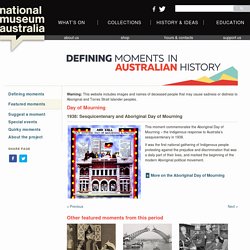
My grandfather protested against Australia Day in 1938. We'll never have a reason to rejoice on that day. Opinion By Ngarra Murray Updated 24 Jan 2018, 7:41amWed 24 Jan 2018, 7:41am Photo: Protesters on Australia Day 1938.

Day of Mourning 1938. [media]On 26 January 1938, as Australians celebrated the sesquicentenary of European settlement, about 100 Aboriginal men, women and children gathered in a hall at 150–152 Elizabeth Street in Sydney, known as the Australian Hall.
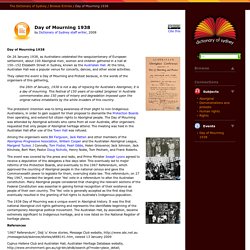
At the time, Australian Hall was a popular venue for concerts, dances, and other social activities. ANALYSIS: 80 years after the Day of Mourning the message for Australia Day still rings true. #ChangeTheDate!

#SaveAustraliaDay! As the latest battle of the hashtags reaches fever pitch, it is worth remembering that the debate over Australia’s 26 January celebrations is not a new one. While Mark Latham and his SAD (Save Australia Day) campaign would have us believe national celebrations are under threat from “left wing loonies” and “out of touch elites”, there is in fact a long history of discomfort and thoughtful debate surrounding January 26th. The 26th of January 2018 marks 230 years since Captain Arthur Phillip decided on Sydney Cove as the site to begin the penal colony of New South Wales. It is also the 80th Anniversary of a historic civil rights protest that challenged the freshly federated Commonwealth’s claim to being a “civilised, progressive, kindly and humane nation”. 26 January, 1938 was declared a Day of Mourning. Aborigines Progressive Association (AITATIS) They called for an end to the protection boards - “No thanks! 01 Apr 1938 - OUR HISTORIC DAY OF MOURNING & PROTEST - Trove.
Australian Institute of Aboriginal and Torres Strait Islander Studies. On January 26 1938, Sydney awoke to a warm, sunny day.
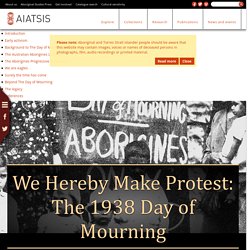
A series of events and activities had been organised to mark the sesquicentenary anniversary. For those who celebrated there was a parade, a sailing regatta and a lawn bowls tournament. One of the feature events of the day was a re-enactment of the arrival of the First Fleet. A group of Aboriginal men from Menindee, in far-west New South Wales, were brought to Sydney to act in the role of the original Eora peoples of Port Jackson. Those who mourned and had little reason to celebrate were kept waiting until the parade passed by. Marking 80 years since the Day of Mourning. How has the legacy of the 1938 Day of Mourning continued to influence you?

JP: The Day of Mourning was not the first protest by Aboriginal people in the face of injustice, but it was the one that became a catalyst for future generations and it was made possible by those who came before. It is, in my thinking, the most critical juncture in Aboriginal political history and laid the platform for all future efforts at both civil and overall human rights. Were it not for the likes of Jack Patten, George Patten, Margaret Tucker, Geraldine Briggs, Bill Onus and the many others who contributed to the day’s success, I would not be in a position of being able to positively impact my community. As a community, we owe every opportunity we have to those pioneers, just as we do to all those who fought for us before them, after them, and who continue to fight for justice today. Remembering 1938 'Day of Mourning' declaration. (Transcript from World News Australia Radio) In 1938 a congress of Aboriginal people met in Sydney to demand equality.
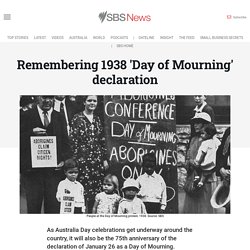
Led by William Cooper, Jack Patten and William Ferguson, they inspired generations of activists to fight for their people's rights. Stefan Armbruster reports on the historic gathering and the calls for an end to celebrations marking the arrival of the first fleet in 1788. "Things were pretty hard and they had to put up with a lot of racism. Day of Mourning protest. Day of Mourning protests held in Sydney - Deadly Story.
On the 26th of January that year, many non-Aboriginal people were celebrating the 150th anniversary of the arrival of Europeans in Australia.

Australian Institute of Aboriginal and Torres Strait Islander Studies. The students that made up SAFA came from many different existing societies including the Australian Labor Party (ALP), the Newman society, the Jewish Students Union and the Civil Liberties Association.
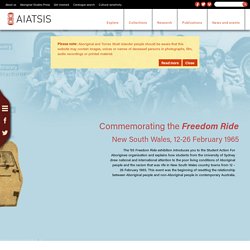
Led by Charles Perkins there were around 35 students that took part in the Freedom Ride. Note: Ages are sometimes approximate, and both age and enrolment in university courses are for February 1965. Australian Institute of Aboriginal and Torres Strait Islander Studies. Explainer: What was Australia's Freedom Ride? What was the Freedom Ride?
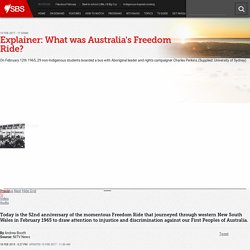
A group of students from the University of Sydney, inspired by the United States 1961 Freedom Rides, got on a bus on 12 February, 1965 and toured through regional towns such as Walgett, Gulargambone, Kempsey, Bowraville and Moree to show wider Australia the experience of Aboriginal Australians. These students - who were known as the Student Action for Aborigines (SAFA) and led by Arrernte man Charles Perkins from Alice Springs - recorded acts of racism against Aboriginal people and broadcast them to media around the country. Where did they go? Walgett RSL Club The Freedom Riders protested outside the Walgett RSL Club on 15 February 1965 because they had been told the club was not permitting entry for Indigenous ex-servicemen. Moree Baths The students travelled to Moree, NSW, and marched to Moree swimming pool to picket prohibiting Indigenous people from swimming in the pool.
Charles Perkins - Freedom Ride - Australian History, Indigenous Studies. Charles Perkins – Freedom Ride is an excerpt from the program Charles Perkins (26 mins), an episode of Australian Biography Series 7 (7×26 mins), produced in 1999. Charles Perkins: In a life of exceptional achievement, Charles Perkins, soccer star, university graduate, Aboriginal activist and Canberra bureaucrat, has often been in strife. In this interview he gives his own account of the personal experiences that fuelled his great anger against white injustice and his determination to fight for Aboriginal rights. 1965 Freedom Ride - The Koori History Website - political history pix index. Lost images of Australia’s 1965 Freedom Ride. Freedom Ride '65. 23 Jun 1965 - HELPING THE ABORIGINES - Trove. 27 Feb 1965 - Freedom riders return - Trove. 08 Apr 1965 - ABORIGINAL LEADER A militant champion of equality - Trove.
13 Feb 1965 - Student ride to tell of Aboriginal misery - Trove. No genteel silence Crux June July 1965. Ann curthoys significance today. Freedom Ride Accomplishments - Charles Perkins. There were arguments both for and against the Freedom Rides in 1965. Although it helped benefit the indigenous population, it was still a controversial affair that generated both praise and critisim from the Australian Public Advantages The "Freedom Rides" in 1965 helped generate a lot of publicity for the Aboriginal equality movement, which led to public pressure on the government to act on Aboriginal discrimination. It exposed the blatant discrimination that were present in country towns and cities, and also helped to support the Aboriginal in taking an active role in resisting discrimination, including seeking effective political representation. Wave Hill walk off, 1966-75. Vincent Lingiari and Mick Rangiari at the sign they asked Frank Hardy to make, 1966 This was probably the first time Gurindji people had seen their name for themselves written down.Source: National Archives, of Australia, Darwin In August 1966, Aboriginal pastoral workers walked off the job on the vast Vesteys' cattle station at Wave Hill in the Northern Territory.
At first they expressed their unhappiness with their poor working conditions and disrespectful treatment. Conversations between stockmen who had worked for Vesteys and Dexter Daniels, the North Australian Workers' Union Aboriginal organiser, led to the initial walk off. The next year the group moved to Wattie Creek, a place of significance to the Gurindji people. They asked Frank Hardy to 'make a sign' which included the word 'Gurindji', their own name for themselves. Wave Hill Walk-Off. Wave Hill Walk-Off 1966: Gurindji strike (or Wave Hill Walk-Off) led by Vincent Lingiari On 23 August 1966, 200 Gurindji stockmen, domestic workers and their families initiated strike action at Wave Hill station in the Northern Territory.
Walk-off at Wave Hill: Birth of Aboriginal land rights. Background of the walk-off The Wave Hill Walk-off followed more than 80 years of massacres and killings, stolen children and other abuses by early colonists. The memories of their brutal treatment over several generations weighed heavily on the minds of Gurindji people long before they walked off the station. Pastoralists who were moving into Gurindji homelands considered the blacksoil plains of the Victoria River District to be prime grazing land.
Conflicts ensued, and Aboriginal elders later remembered how white stockmen "shot them like dogs", took their women for sexual gratification or let children witness the murder of their parents or uncles. The untold story behind the 1966 Wave Hill Walk-Off. * Aboriginal and Torres Strait Islander readers should be aware that this article contain images, voices and names of deceased people. Australian Institute of Aboriginal and Torres Strait Islander Studies. Australian 1967 Referendum.
What was Australia's 1967 Referendum about? There are common misconceptions about what the 1967 Referendum actually changed. The 1967 referendum. The 1967 Referendum. ‘Right wrongs, write Yes’: what was the 1967 referendum all about? 1967 Referendum: 23/05/2017, Behind the News. The 1967 referendum saw the majority of Australians vote to change our country's laws to count Indigenous Australians as full citizens. The 1967 Referendum. Aboriginal and Torres Strait Islander peoples are advised that this research guide contains names and images of deceased people.
The 1967 Referendum. Treaty Republic - Indigenous Australia Sovereignty, Genocide, Land Rights and Pay the Rent Issues. Vote yes for Aborigines : ClickView. Aboriginal Embassy, 1972. We want land rights, not handouts Alan Sharpley with placard, Bob Perry in a Ningla-a-Na T-shirt and John Newfong with hands on hips at the Aboriginal Tent Embassy in Canberra. The Pitjantjatjara expression Ningla-a-Na is translated as 'we are hungry for our land'.
Source: Ken Middleton collection, National Library of Australia Late on Australia Day 1972, four young Aboriginal men erected a beach umbrella on the lawns outside Parliament House in Canberra and put up a sign which read 'Aboriginal Embassy'. The history of the Aboriginal Tent Embassy. Updated 27 Jan 2012, 2:50amFri 27 Jan 2012, 2:50am. Aboriginal Tent Embassy. Aboriginal Tent Embassy, Canberra. Education resources for schools teachers and students - ABC Education. The Mabo decision - original ABC TV News report. Mabo - a timeline. Australian politics explainer: the Mabo decision and native title. Mabo decision. Mabo v Queensland (No 2) [1992] HCA 23; (1992) 175 CLR 1 (3 June 1992) Mabo : life of an island man : ClickView.